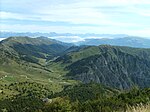Monte Grappa

Monte Grappa (Venetian: Mónte Grapa) (1,775 m) is a mountain of the Venetian Prealps in Veneto, Italy. It lies between the Venetian plain to the south and the central alpine areas to the North. To the west, it is parted from the Asiago upland by the Brenta river, and to the east it is separated from the Cesen-Visentin massif by the Piave river. To the north lie Corlo lake and Feltre valley. In the past, the mountain was called Alpe Madre (Mother Alp), and is currently divided among three provinces: Vicenza to the west, Treviso to the south and Belluno to the northeast. It is the highest peak of a small massif, which also includes many other peaks such as Col Moschin, Colle della Berretta, Monte Asolone, Monte Pertica, Prassolan, Monti Solaroli, Fontana Secca, Monte Peurna, Monte Santo, Monte Tomatico, Meatte, Monte Pallon, and Monte Tomba. In September 2021, UNESCO announced that Monte Grappa would become one of 20 new biosphere reserves as part of their Man and the Biosphere (MAB) Programme.
Excerpt from the Wikipedia article Monte Grappa (License: CC BY-SA 3.0, Authors, Images).Monte Grappa
Via Eroica, Pieve del Grappa
Geographical coordinates (GPS) Address Nearby Places Show on map
Geographical coordinates (GPS)
| Latitude | Longitude |
|---|---|
| N 45.873333333333 ° | E 11.799166666667 ° |
Address
Via Eroica
31017 Pieve del Grappa
Veneto, Italy
Open on Google Maps







